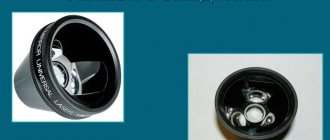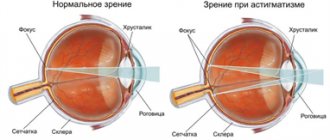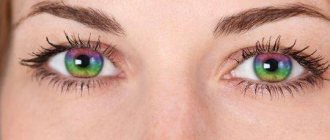One of the main dilemmas faced by the buyer is related to the safety of using contact optics. Is it harmful to wear lenses, do they worsen vision, how can you tell if the product is selected or used incorrectly? Everything you wanted to know about contact lenses can be found in this article.
Are the concerns justified?
The first contact lenses (CL), which began to be produced en masse in the 50-60s of the twentieth century, were made exclusively from organic glass. Wearing them caused discomfort, created a feeling of a foreign body in the eye and created an obstacle to oxygen access. Constantly wearing such lenses was uncomfortable and dangerous for the cornea, which was deprived of proper breathing.
Modern CLs are made from biocompatible water-gradient materials, such as silicone hydrogel. It does not cause irritation to the tissues of the ocular apparatus, supports the natural environment of the organ of vision and does not impede metabolic processes.
If all medical requirements are met (they will be discussed below), wearing CL will not only be safe, but even useful.
In addition, there is a misconception that contact lenses should not be worn by people over 40 years of age - contact optics can be safe at any age .
Can vision deteriorate?
Proponents of the arguments against wearing lenses argue that any optics significantly impairs visual acuity. They attribute this to the fact that the eyes in the CL stop “working”, since all visual functions are taken over by the optics. Only the illusion of good vision is created, but in reality it is rapidly deteriorating.
A counterargument can be put forward to this statement: vision can deteriorate on its own, regardless of whether the patient wears a CL or not . The sensation of decreased acuity is based on contrast. The picture created by the lens is very natural, bright and clear. When the patient removes the optics, the image immediately loses contrast and saturation. Therefore, a false impression is created that vision has deteriorated, and the reason for this was contact lenses.
It is also erroneous to say that CLs lead to the development of myopia in childhood. Studies have shown that there is no decrease in visual acuity in children who were prescribed lenses . On the contrary, any optics can have a therapeutic effect specifically for young patients, helping to get rid of farsightedness or myopia.
Myths about harmfulness
There are countless “fairy tales” and speculations circulating among ordinary people regarding contact lenses. For many “bespectacled” people, such negativity becomes an insurmountable obstacle to “friendship” with a modern device for eliminating eye pathologies.
Myth No. 1: Lenses gradually worsen vision.
It drops whether you use optics or not. Then where did this opinion come from? Everything ingenious is simple: by putting on “correction plates”, a person sees the world around him more clearly and brightly. After he takes them off, the image becomes blurry and the patient decides that his vision has deteriorated significantly.
In reality, the eyes quickly get used to the “pleasant” picture, and the resulting contrast leads to imaginary blindness.
Myth #2: Contact lenses cause eye irritation.
To create modern optics, materials are used that are compatible with the human body; they are not capable of causing irritation to the eyeball. If the product is selected correctly and used in accordance with all the rules, it will not cause negative consequences or discomfort.
| Most lenses have high transmission capacity, so the eye is not afraid of hypoxia. To ensure your eyes rest and are saturated with oxygen in the required amount, be sure to remove your optics before going to bed. Don't forget to clean and disinfect it. |
Myth #3: Contact lenses cure myopia
How does a patient with vision problems think? I’ll buy a couple of lenses, wear them for a week or two, then take them off and I’ll see perfectly. In reality, the therapeutic effect can only be exerted on adolescents and young children. After eighteen years of age, only a surgeon can eliminate myopia or farsightedness.
Myth #4: Wearing lenses is a difficult and painful process.
High-quality optics are not felt on your eyes, sometimes you even forget that you are wearing them. Use does not cause discomfort.
Removing and putting on lenses is a simple process that even a child can master. When choosing a product, the doctor explains in detail and shows how to use it correctly. There are also several practical sessions where the patient himself tries to remove and put on the optics.
Myth #5: Lenses are no different from glasses.
This can only be said by someone who has never broken glasses when falling or cried over a failed date, believing that the culprit was “unattractive glass in a horn-rimmed frame.” Of course, modern models are distinguished by elegance and grace, but lenses give depth and expressiveness to the look. You can play sports in them, swim in the pool, they do not narrow your horizons and additionally provide protection from ultraviolet radiation.
Myth No. 6: the dye in colored lenses is toxic to the eyes and the body as a whole.
The optics used to change the color of the iris use safe pigments. The paint is located between two layers, so there is no direct contact with the mucous membrane. If concerns remain, buy the product in specialized stores.
Myth No. 7: Lenses are very expensive
The price of products depends on many factors, from the manufacturer to the quality of the material. The most expensive ones are those that need to be changed every day. All other options can be afforded by the most ordinary citizen. A set of thirty records will cost one thousand rubles. If you think this is an expensive pleasure, take a closer look at lenses with a long service life.
You can learn a lot of interesting things about myths regarding vision correction devices from the video
Return to contents
Are lenses without diopters harmful to vision?
Colored lenses without diopters can be used if your vision is good, but you want to slightly change your image. They are made from the same material as regular CLs, only with the addition of pigment. The dye allows you to radically change the color of your eyes or highlight the beauty of your own iris shade.
The pupil area in colored lenses remains uncolored, the pigment does not come into contact with the membranes, and therefore does not in any way affect the quality of vision and the health of the eye as a whole. If all the conditions for using color contact lenses are met, devices without diopters will be absolutely safe.
ARTICLES ON THE TOPIC:
- Tips on which contact lenses are best to choose for vision correction, among...
- How to choose the right colored contact lenses and not be disappointed by the change...
- Important question! Are colored contact lenses harmful to the eyes, including for children...
But you must take into account an important nuance - contraindications. There are a number of pathological conditions of the organ of vision in which wearing contact lenses is prohibited.
How to use colored lenses so they can't cause harm
There are several rules, knowledge and use of which will ensure wearing colored lenses with comfort:
- So that buying lenses does not turn out to be a waste of money and a provocateur of various eye problems, do not be too lazy to go to an ophthalmologist, even if you have not observed any problems. There are many factors due to which it is strictly not recommended to use lenses. Find out if you have any.
- An important rule is proper selection. If, for example, you buy lenses with diopters for eyes that have perfect vision, you will ruin it. Therefore, do not hesitate to ask sales consultants and ophthalmologists, especially if you have a minimum of information about colored lenses.
- You need to ask not only about the colored lenses themselves, but also about the products that go with them. Don't skimp on what you should buy to make wearing them as comfortable as possible.
- When trying on lenses, basic hygiene is required. Wash your hands before applying them to your eyes. If there is no source of clean water nearby, use an antiseptic. You should also remove the lenses with clean hands.
- Pay attention to how long these small eye decorations are designed to last. Wearing them longer than the period indicated on the package is strictly not recommended. For example, if you bought disposable lenses for an event, you can wear them for no more than one day. Even if you only wore them for a few hours, you should dispose of them the next day.
- Not removing your lenses at night is a huge mistake, fraught with extremely unpleasant consequences. To avoid them, remember to take them off before going to bed.
- If you are sure that you did everything correctly, but the lenses cause particular discomfort, stop wearing them and go for a consultation with a good ophthalmologist. It is possible that eye features were not identified during the initial examination or were acquired later.
Video - how to put on and remove any lenses
For whom are they contraindicated?
Even the highest quality contact lens is considered a foreign body for the eye, since it is in direct contact with the mucous membrane, in contact with the eyelids and tear secretion. For this reason, ophthalmologists prohibit wearing contact lenses in case of inflammatory diseases of the tissues and membranes of the eyeball, such as:
conjunctivitis;
- keratitis;
- blepharitis;
- uveitis;
- scleritis;
- iridocyclitis;
- dacryocystitis;
- inflammation associated with allergic reactions.
A CL, which is placed on the inflamed membrane, will cause additional irritation and will delay the healing process for a long time.
There are other contraindications:
- subluxation of the lens;
- strabismus with an angle of 15 degrees or higher;
- drooping eyelid (ptosis);
- glaucoma;
- excessive or insufficient secretion of tears;
- xerophthalmia associated with increased dryness of the conjunctiva and cornea;
- obstruction of the lacrimal ducts.
Additional temporary contraindications include infectious and colds: sinusitis, rhinitis, influenza, ARVI, bronchitis, tuberculosis. With any infection, pathogenic bacteria end up on your hands and face. Therefore, when putting on lenses, you can introduce a virus or microbe to the mucous membrane of the eye. This can lead to the development of an infectious process in the structures of the eyeball, which becomes extremely dangerous for vision.
REFERENCE: With the advent of one-day silicone hydrogel lenses, diabetes mellitus was excluded from the list of prohibitions on wearing contact lenses.
The main advantages of night lenses are as follows:
- Effectively correct moderate cases of myopia (up to -7 diopters);
- Unlike laser vision correction, it can be used up to 18 years of age;
- You don't have to wear it at night every day. The improvement in vision is reversible and each time lasts up to three days, depending on the severity;
- Unlike surgery, overnight models may not cause serious side effects ;
- Do not cause allergic reactions, help prevent certain eye diseases, such as conjunctivitis and keratitis;
- When wearing it, it is not so critical to use moisturizing drops. No need to carry an extra pair of products and a case;
- No dry eyes;
- Excellent for people in professions for whom wearing glasses or regular lenses is contraindicated , and eye surgery is also prohibited.
How do you know if lenses are not right for you?
CL is a special medical product that meets the most stringent standards. They are made from high-quality hypoallergenic materials and are therefore considered safe. Allergy to optics is practically excluded, so reactions intolerance to CL are very rare .
You can tell that contact optics are not suitable for a patient by the following symptoms:
photophobia;
- painful sensations in the eyes;
- swelling and tearing;
- redness of the eyes;
- burning sensation and dry eye.
Similar symptoms are usually accompanied by acute conjunctivitis, but lens intolerance can manifest itself in the same way. This phenomenon can be considered as a physiological reaction to a foreign body, which is CL. Signs of such pseudo-allergy are not uncommon among beginners who are just adapting to CL. Within a week, when the eye gets used to the optics, redness, burning and lacrimation should go away on their own.
ADVICE: Doctors prohibit beginners from wearing lenses without removing them. To quickly get used to contact lenses, you should wear them correctly for short periods of time and use moisturizing eye drops.
What are the benefits of contact lenses compared to glasses?
Despite the advantages of contact lenses, they are also not without disadvantages. Let's list them:
- Lenses are difficult to put on . In the first days, it may take 20-30 minutes, and sometimes a whole hour, to put on or take off a pair of contacts. But once you get used to it, you will do it quickly. You don't even need a mirror.
- Lenses are difficult to care for . Yes, it’s not easy to get used to new procedures at first. But then you will stop noticing them, as you will start doing them automatically.
- The first days of wearing lenses may be painful . If a person puts on a CL for the first time, he may actually feel discomfort and even pain. Then you need to wear the lenses for a short time, allowing your eyes to get used to it. The first day is 1 hour, the second day is 2 hours, and so on. If adaptation does not occur within a week, you need to change the contact pair.
- CL is more expensive than glasses . This drawback does not apply to all lenses, but most often it does.
- There is a need for moisturizing drops . Typically, patients are prescribed silicone hydrogel lenses, which are mostly made of water. To prevent them from drying out right before your eyes, you need to use moisturizing drops. A simple tear lubricating the mucous membrane of the eye is not enough.
Attention! Sometimes the disadvantages include a high risk of eye infections. But in fact, contact lenses cannot cause such harm. Infection can enter the eyes only if the patient does not follow the rules of wearing and caring for contact lenses. If he doesn’t get used to them, then it’s better to give preference to glasses.
Having considered the pros and cons of contact lenses, you can conclude for yourself which is better: them or glasses. We emphasize that both the first and second ones can be harmful to vision if they were incorrectly selected. To prevent this from happening, if you need to correct your visual ability, contact an ophthalmologist. Only he can choose lenses or glasses that will improve visual acuity and not cause harm to the eyes.
What to do if you have symptoms of an allergy or intolerance?
If, 7 days after starting to use the lenses, signs of an allergic reaction are observed, it is necessary to find out the cause of the symptoms.
Allergic reactions to a specialized solution for CL. Often intolerance is caused by preservatives, which are necessarily included in the composition of the liquid. Sometimes allergies occur when changing the type or manufacturer of the solution. Solution : by trial and error, select the appropriate composition or switch to daily lenses that do not require the use of a solution.
Changing lens type. Incorrectly selected lenses, features of products of a certain brand can cause intolerance and discomfort. Solution : together with an ophthalmologist, select the “right” contact lenses.
Failure to comply with hygiene rules. Untimely change of solution, neglect of the timing of replacement of optics, insufficient cleaning can lead to the penetration of microbes into the mucous membranes of the eye and cause inflammation. The situation is also aggravated by protein deposits that accumulate on the surface of the lens and serve as a breeding ground for the proliferation of pathogenic microorganisms. Solution : strictly follow the rules of hygiene and the timing of wearing contact lenses.
General allergic reactions. Allergies to dust, plant pollen, and animal hair can aggravate CL intolerance. The contact of tiny particles of allergens with the lens can cause severe allergic reactions. Solution : visit an allergist to identify the type of irritant and draw up a treatment plan.
Only a doctor can accurately determine the cause of lens intolerance. Therefore, if severe allergy symptoms occur, you should seek medical help. The ophthalmologist will make an accurate diagnosis,, if necessary, refer for additional examinations and consultations, and then prescribe treatment.
IMPORTANT ! Discomfort in the eyes can be caused by an incipient corneal ulcer or infection, so consultation with a doctor is required.
Are there any benefits from lenses?
Correctly selected lenses can have a positive effect on visual function and eye condition:
relieve the load on the muscular system of the eyeball;
- eliminate eye fatigue;
- serve as a therapeutic agent for children suffering from myopia and farsightedness;
- protect the eyeball from ultraviolet radiation (optics with a light filter);
- create the correct picture, do not distort the shape, size, distance to objects;
- help to build a correct image in patients with varying degrees of visual impairment in the right and left eyes;
- hide visible defects of the eyeball.
CLs are good because they allow you not to limit yourself in physical activity and sports . They do not fog up when the temperature changes and do not create inferiority complexes in children and adolescents.
How to wear CL correctly
The key rule for selecting lenses is consultation with an ophthalmologist. The specialist has the necessary diagnostic tools to examine vision, detect abnormalities and contraindications. The doctor will select the “correct” diopters and make recommendations for wearing optics.
What else needs to be observed:
- CL wearing mode – most often it is recommended to remove the optics at night and not use them for longer than the time specified in the instructions;
- expiration date - expired products must not be worn;
- hygiene rules - wash your hands thoroughly before putting on and taking off, use lint-free towels;
- moisturizing mode - special drops, similar in composition to tear fluid, will help eliminate discomfort.
Only daily lenses do not require special care. All other types of contact lenses must be properly stored, worn, and cleaned every day. For this purpose, special devices and entire sets have been invented, which include storage containers, tweezers and solutions. The optics should be treated after each removal and before putting them on. Between wearing periods, the products are placed in a special container with a solution that will disinfect the contact lenses and maintain the necessary moisture content of the material.
Damage to lenses. Contact lenses: pros and cons.
Damage to lenses. In what cases does it manifest itself? What are the advantages and disadvantages of contact lenses? When are lenses harmful to vision? How to select lenses? What are decorative contact lenses? What is the difference between soft and hard contact lenses? What are overnight contact lenses? What are the rules for wearing contact lenses? When was the first contact lens fitted?
Contact lenses
Contact lenses have long ceased to be a curiosity. However, in our country they are used less often than glasses. But in vain. While some minor harms from lenses exist, contact lenses are much more comfortable to wear and offer several significant benefits.
Elena (25 years old) switched to soft contact lenses two years ago and, in general, did not feel any particular harm from the lenses. Previously, the girl wore glasses. “I wasn’t always comfortable with glasses. In the heat, my glasses slipped down onto the tip of my nose, putting pressure on my ears and the bridge of my nose. Inconveniences also arose in the rain, says the girl. “But it was hardest in winter. Every time I entered a room from the cold, the windows instantly fogged up.” After Elena broke her third pair of glasses, she decided to try contact lenses and consulted an ophthalmologist. After a thorough examination, the doctor selected soft contact lenses for her from a special material - hydrogel. The harm caused by lenses made of this material is almost invisible. “I got used to them almost immediately and no longer feel any discomfort,” Elena shares her feelings. “On the contrary, significant advantages have appeared.” The girl made sure that contact lenses, unlike glasses, do not become covered with perspiration, do not limit the viewing angle and do not distort the image. “I feel very free, I see well and I’m not afraid that the lenses will fall and get scratched,” says the girl. “And driving a car has become much more comfortable.”
Indeed, contact lenses “win” compared to glasses. Perhaps their main advantage is natural vision. In addition, contact lenses do not distort the image, offer a full viewing angle, do not become covered in perspiration when the temperature changes in winter, and do not have “dead zones.” This is their significant advantage, and there is practically no harm from lenses.
Decorative contact lenses
Decorative contact lenses allow you to enhance or radically change your eye color. They are more needed for beauty than for vision. Such contact lenses are worn in disco clubs, at proms, or to take photographs for a foreign passport and when traveling abroad. By the way, in France they prefer green lenses, in Spain - curry, in England - yellow. The choice of decorative contact lenses is very large, and there is no harm from lenses of this type when used correctly. Do you want - with a red light, do you want - a zebra or reflective in ultraviolet light. A correctly selected contact lens fits well on the eye and moves with it. Therefore, a person feels at ease and comfortable. The risk of blinking or losing a contact lens during sudden movement or tilt is minimal.
Modern soft contact lenses are made of hydrogel, a substance that absorbs a certain amount of moisture. They are very elastic, do not cause discomfort and are not noticeable on the eye. At the same time, the damage to the lenses is minimal. The likelihood of them falling out or being displaced is negligible. In addition, it happens that glasses interfere with the use of personal protective equipment: masks, spacesuits, helmets. Then you can't do without contact lenses. The list of such professions has long been defined in the United States. Some workers are suitable for glasses, others - contact lenses or laser vision correction. Unfortunately, we do not yet have such an approach. But there is a need for it.
Hard and soft contact lenses
Depending on the material, there are two types of contact lenses - hard and soft. Each type has its own characteristics. Thus, hard contact lenses are more flexible and durable. However, their selection is somewhat more difficult, and the adaptation period lasts longer.
Hard contact lenses are prescribed for certain diseases. For example, when a person has keratoconus. Then the cornea of the eye changes its shape to a cone-shaped one. By the way, this disease occurs quite often. Hard contact lenses are also prescribed for high myopia, astigmatism, and irregular cornea shape. Glasses are ineffective in such cases.
“One of the patients with high grade keratoconus did not want to wear hard contact lenses,” says the doctor. “So he had to buy new glasses every few months due to changes in their prescription.” When the man was getting ready to travel abroad, the ophthalmologist selected hard contact lenses for him. He felt all the benefits and didn’t want to go back to glasses.
“With the help of contact lenses, you can correct almost all defects in the optical system,” continues the doctor. “In particular, the consequences of injuries, operations, albinism (a birth defect when there is not enough pigment and the eye glows red), scars, changes in the shade or color of the eyes.”
Recently, a mother brought a nine-year-old boy to an ophthalmologist. After examining the little patient, the doctor selected hard contact lenses for him. Four years ago, a child had an accident - the boy injured his right eye with a nail. A scar remained at the site of the injury. He wore glasses for several years. However, they do not completely correct the defect: the child’s left eye sees well, but there are problems with the right. As a result of the injury, the boy's cornea changed shape. In this case, only a hard contact lens will do. Getting used to hard contact lenses is quite difficult, especially if it is on one eye. But if there is no other way out and the main thing is that the child has a desire, the adaptation process is easier than for adults.
Among soft contact lenses, the so-called quarter lenses are the leaders. Based on the duration of wear, such lenses are divided into daily, biweekly, quarterly and annual. About 70% of our fellow citizens who are suitable for soft contact lenses prefer quarter ones. They need to be changed every three months.
Another thing is Western European countries, where, despite their income, two-week contact lenses “lead”. It is advisable to remove lenses at night. However, there are different situations in life: a long vacation, a business trip, childbirth, a vacation in the mountains, when there are no necessary conditions for hygiene. In such cases, special silicone hydrogel contact lenses are suitable. They can be used continuously, i.e. without taking it off at night. The maximum period is 30 days. If you have any problems with your contact lenses, you should contact your doctor immediately rather than trying to solve them yourself.
How to choose lenses correctly
You should buy contact lenses at a designated place. They cannot be purchased according to the scheme: come, buy, leave. Selection of contact lenses by a qualified specialist is required. Fitting and assessment of the position on the eye, as well as further dispensary observation of the patient.
If you have a cold, it is better to remove your contact lenses. In some cases, you cannot wear contact lenses, both hard and soft, otherwise the damage to the lenses may be significant. So, it is better to avoid lenses in case of chronic inflammatory diseases: inflammation of the cornea - keratitis or inflammation of the iris - uveitis.
Another contraindication in which lens insertion can make itself felt is an insufficient amount of tear fluid. To determine this, ophthalmologists conduct a test - they insert special strips into the eyes, which after five minutes become damp by a certain number of millimeters. If a person does not have enough tear fluid, but there is an urgent need for contact lenses, moisturizing centers containing artificial tears are added to them.
If a person has a runny nose and elevated body temperature, it is better to wait for recovery and not wear lenses during the illness. If this is neglected, then the harm of the lenses can manifest itself in the fact that the inflammatory process can occur directly in the eye.
As for age, age is not a contraindication to the use of contact lenses. If necessary, they are prescribed even to infants.
You get used to soft contact lenses faster. The main thing when selecting contact lenses is a thorough examination of the patient and an individual approach. It is necessary to take into account everything: the material from which the lenses are made, the type of activity of the patient, his wishes, and, of course, the peculiarities of the structure of the eye. The selection of contact lenses is preceded by a full examination. An ophthalmologist examines visual acuity and refractive power of the eye, measures intraocular pressure, conducts studies of the structures of the organ of vision and its fundus, and also measures the parameters of the cornea to establish the parameters of a contact lens. But that is not all. To determine whether soft contact lenses are suitable for a patient, 15 minutes to half an hour is enough, explains the ophthalmologist. Hard contact lenses take longer to fit. In Soviet times, this could take up to two weeks. Now we are trying to fit it into a day or two: selection, production of contact lenses and installation. After 10 days - for a follow-up examination.
A person wearing contact lenses must adhere to all the conditions that the doctor pays attention to during the first selection, namely, do not neglect the rules of hygiene and make timely replacements. Then there will be no problems with them and the damage of the lenses, as such, will not be felt at all.
Night contact lenses
Instead of surgery - night contact lenses. Day contact lenses are used to correct vision defects, and night contact lenses are used for therapeutic purposes. Today, hard night contact lenses made of a special material - paragon - are often used to treat mild and moderate myopia in children. The child wears them only at night. After a month of use, a wearing regimen is selected for him.
It all depends on the characteristics of the cornea: some patients wear them every night, others - once every two or three nights. The main effect of this therapy is to inhibit the progression of myopia in childhood without surgery. As a result of this procedure, the shape of the cornea changes; the child sees with his own eye. After a month and a half, the desired effect is achieved. This is one hundred percent vision and the absence of myopia.
Rules for wearing contact lenses
- Contact lenses should be stored in special containers (a new pair of lenses - a new container, if desired - frequent replacement).
- You should wash your hands before touching contact lenses.
- You cannot exceed the permissible period of wearing contact lenses (8-14 hours a day), otherwise damage to the lenses can easily occur.
- Every time a person puts on lenses, the lenses need to be changed. solution.
- Once you have your contact lenses in, be careful when using hairspray, deodorants, and aerosol perfumes.
- If you catch a cold or suffer from seasonal allergies, it is better to temporarily replace your lenses with glasses, otherwise the damage from the lenses will not take long to occur.
- If you are always in a smoky room, your contact lenses may change color and lose their properties.
- Choose high-quality cosmetics: mascara should not crumble, and eyeliner should not smear, otherwise, if they come into contact with the lenses, they and your vision may be damaged.
- If you have sensitive eyes, use hypoallergenic cosmetics or special cosmetics for contact lens wearers. First put on your lenses, then do your makeup, first take off your lenses, then remove your makeup.
- If you take a shower, do not expose your face to the flow of water: contact lenses may “float.”
- If you go to the sea, do not dive with your eyes open. Salty seawater can change the structure of your contact lenses, causing them to become washed out.
Interestingly, the first contact lens was glass. It was installed in 1887 on a patient with removed eyelids. The “glass” served him for more than 20 years.










